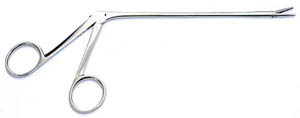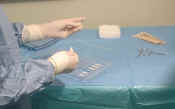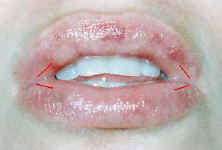-
How many techniques are there to augment the lips?
A lot. Seriously, there are so many that you should read this website in its entirety. Lip augmentation falls into two basic categories: surgical (implants) and non-surgical (injectables).
Lip implants:
-
Advanta
-
AlloDerm
-
Dermis grafts
-
Fascia grafts
-
Gore-Tex
-
SoftForm
-
Tendon Grafts
-
UltraSoft
Injectables:
-
Artecoll
-
Aquamid
-
Bio-Alcamid
-
Bovine Collagen
-
Human Collagen
-
Particulated Dermis
-
Perlane/Restylane
-
Porcine Collagen
Back to Top
-
What types of injectables are out there and what are the differences?
Most available injectables are temporary. Collagen, which has been the industry leader for a very long time, usually lasts only 3 to 4 months and requires a skin allergy test. Fascian lasts a little longer, although not much. In theory, Fascian sounds wonderful because it's made up of fascia lata, strips of the tough covering that surrounds the outer thigh muscle that are harvested from cadavers. It reportedly lasts longer than collagen, although I have not had the chance to test it out myself. But, I must say I have received many reports of lumpiness, inflammation and high prices.
Cymetra is a particulated injectable version of AlloDerm, a cadaveric dermis graft, that seems to last a lot longer. Unfortunately, everyone I have spoken to who has used it for lip augmentation says Cymetra only lasted a short time for them and that it was very expensive. I heard from the company that it is supposed to be layered over a 2 year period for best benefits, but who has 2 years and a second mortgage to spare for that?
There are a few injectable products that are permanent, such as Artecoll, Aquamid, Metacrill, and silicone oil (Silikon 1000 and Adatosil 5000, which are used off-label). Artecoll is made from PMMA (polymethylmethacrylate) microspheres suspended in a mixture that includes lidocaine and bovine (cow) collagen. PMMA is delivered into the dermis by the collagen vector, the collagen is then broken down by the body over time, yet the PMMA microspheres are left behind to be encapsulated by the body's own collagen. These microspheres are "networked" together by your body's collagen structure, creating the augmentation.
Aquamid, Bio-Alcamid, Argiform, and other polyacrylamide implants are made from a polymer that holds moisture. This type of product has been used in medicine and agriculture for decades. If you have ever seen the bluish or clear gelatinous globs that plants are grown in, it very well may have been polyacrylamide.
The benefit of an injectable is the volume it can give the lips. The poutiness it imparts is significant compared to the implants, which give a more subtly defined lip. The downfall is you really need an experienced injector. This is imperative, especially with the permanent products.
Please read the Micro-Implant Section for more on Artecoll, Metacrill, Silicone and other permanent options, including the reported risks.
Back to Top
-
Are there any permanent options in lip augmentation?
There are permanent and reversible options like Gore-Tex (which I have), SoftForm, UltraSoft and Advanta soft tissue augmentation implants made from expanded polytetrafluoroethylene (ePTFE). These implants are made from a white material that's best described as similar to foam-rubber. ePTFE has been used for decades in the body for all sorts of applications. These are the most popular and the only FDA approved synthetic implants which are considered permanent, yet they are removable in the event of a problem. The risks are infection, extrusion, palpability and lessened mobility of the treatment areas.
Of course, there are permanent injectable options, which can create that poofy look that has come to be associated with some lip augmentations, like Angelina Jolie's. These include Artecoll, Metacrill, Aquamid and silicone oil. The downfall with these implants I (s their permanent nature, and the risk of necrosis, granuloma, nidus, severe inflammation, palpability, extrusion and infection.
Please read the Micro-Implant Section for more on Artecoll, Metacrill, silicone and other permanent options, including the reported risks.
Back to Top
-
How is lip augmentation with lip implants performed?
The surgery is not complex, nor does it take a substantial amount of time to perform. You are injected with Lidocaine for pain relief and epinephrine, a vasoconstrictor, to restrict the amount of bleeding and bruising. After making the necessary 4 incisions at each corner of the mouth, the surgeon inserts the implant using either an implant prethreaded on a trocar (a hollow cylinder with a sharply pointed end), or by using a pair of alligator forceps. After insertion, the surgeon cuts the implant to the right size for your lip and trims the ends of the implant. The incision areas are then sutured with a thin dissolving or non-dissolving suture and you are cleaned up.


There will be only the smallest amount of blood during the procedure due to the injections of epinephrine.
Back to Top
-
Where are the incisions made?
In a lip augmentation procedure with implants, the incisions are made on each side of the mouth right before the corner where the lips meet, resulting in 4 small incisions and little or no scarring. In the illustration I have depicted the incision placement with red lines. The lips tend to heal quite fast as long as you don't mess with them. These means no touching or picking at your incisions! Infection is already a risk, so try not to increase your chances of it.

Back to Top
-
What should I expect postoperatively?
You should expect to be swollen, tender and very full-lipped postoperatively. You may also difficulty drinking or eating without spilling. There will be pain, especially if pressure is applied to your lips. You may feel numb in the lips for several days while swelling puts pressure on the nerves in your lips. You should be thankful for this, because when the numbness dissipates you may feel more discomfort. Pain relievers prescribed by your doctor should alleviate any discomfort.
Your sutures will be removed in about 7 to 10 days. It may sting a bit during removal, especially if your skin gets nipped by the small scissors. The swelling will be apparent, but you had the surgery for augmentation, didn't you? Once the swelling subsides, you may wish for a little more poofiness -- this is normal. For a reality check, compare your before pictures with an after shot before passing judgment.
Back to Top
-
Is it quite painful? Is there much bruising?
It takes about a week for most of the swelling to subside, although your lips will be sensitive to light to medium pressure for about 3 weeks. There is really not too much bruising with average cases, although individual cases may vary. Some patients are more prone to bruising than others. Some doctors suggest that you use Arnica montana or Bromelain, and you may be instructed to use a topical arnica ointment as well. These three products are thought to decrease both bruising and swelling in all procedures.
Back to Top
-
Will I have to premedicate for dental work?
It is quite possible that you will have to premedicate to prevent infection in the cavity where the lip implant (or any implant, for that matter) is located.
Some surgeons think that plaque and bacteria are set free during dental work and enter into the blood stream via minute lacerations in the mouth. The bacteria searches for weaknesses in your body to latch itself onto, causing an infection. However, this issue is controversial and some surgeons believe that the same type of bacteria is released during routine flossing. I have personally never had a problem after the initial healing period, although I did have an infection which occurred several months postoperatively which required the removal with my first set of implants.
Back to Top
-
When will I be able to see the results?
The visible results are usually immediate. For implants, fat grafting and most injectables, your lips will be quite large and swollen and you will see a difference in the swelling as it subsides over the first week. The swelling will more than likely subside more than you would like as you become accustomed to their enormous size and think that your new lips are small by comparison. You should take photos before and after to appreciate the change in lip volume.
With implants that require stimulation of your own collagen (Artecoll, Metacrill, Isolagen, and silicone oil), you may notice swelling at first. After it subsides, growth will occur in the weeks following injection. Patience is a virtue with these types of procedures. Over-correction is not recommended. Please know that adding is a lot easier than removing when it comes to lip augmentation.
Back to Top
-
What are the risks of lip augmentation?
There are not too many risks associated with lip augmentation when compared to other elective procedures, but there are enough to pay attention and be concerned. Risks typically depend on the chosen implant or filler.
Let's start with Gore-Tex, SoftForm, UltraSoft and Advanta. All can cause infection and irritation if the ends of the implant are too long for the cavity or were not rounded off. The good thing is that it is reversible and can be readily removed. UltraSoft is hollow, allowing your own tissues to grow into the implant. When tissue ingrowth occurs, infection and rejection are less likely. Extrusion from the body attempting to reject the foreign material, palpability and lessened mobility of the treatment areas are all possible. Migration can be an issue as well, although tissue ingrowth can decrease this risk significantly. There may be permanent discolorations from the bruising. Possible hematomas resulting in additional surgeries and excessive scarring from delayed healing or trauma are also risks, as is a deformity from excess scar tissue arising from an infection or the hands of an unskilled doctor.
Fascian, AlloDerm, CosmoDerm, CosmoPlast and other forms of cadaveric grafts or tissue derivatives supposedly are absorbed within your body with no after-effects. Newer injectable fillers like Restylane, Perlane and Hylaform supposedly have no side effects. However, some patients have reported prolonged swelling and inflammation, and nodules at the injection sites with Perlane.
Artecoll, Metacrill, silicone and other permanent injectables have their risks as well. Not only can the risks include infection, necrosis, granuloma formation, nidus, severe inflammation, palpability, and extrusion, but the injected material is not easily removed in the event of a problem. If there is a problem, injections of Kenalog, a corticosteroid, can help alleviate inflammation and reduce fibrous tissue. If the need for repeat injections persists, excision is usually the only option to lessen the amount of product in the tissue which is triggering an inflammatory response.
Injectable products made from hydrophilic polyacrylamide gel do have some questionable issues, one being residual unpolymerized acrylamide. Acrylamide is a known carcinogen, mutagen, neurotoxin and also a reproductive toxin. However, the manufacturers report that the levels are extremely small, less than what you would receive on a daily basis from drinking water and foods. The other issue is the ability to sustain bacteria. Bacteria can and does thrive within polyacrylamide implants. Infection is a possibility and may be treated with localized injections of antibiotics, as well as a course of oral antibiotics. Aspiration, and or excision, may be necessary in some cases.
Back to Top
-
What are Arnica montana and bromelain? I have heard that they reduce swelling and bruising. Which is the best kind to take?
Arnica montana is a perennial herb that has been used as part of European herbal medicine for over a thousand years for the reduction of bruising and swelling and to shorten the recovery period after physical trauma. Like many medicinal plants, if ingested raw Arnica Montana can cause intestinal bleeding, abdominal cramping and sickness. It should only be taken as part of a respectable homeopathic remedy or tincture. There are many formulations from different companies. Sublingual (under the tongue) types are the most often recommended for plastic surgery.
Bromelain comes from the pineapple plant and is another anti-inflammatory formula containing a proteolytic enzyme that is capable of dissolving proteins. It is most often used after sports injuries or surgical procedures to relieve swelling. Always ask your surgeon first before taking any medication.
Back to Top
-
I have heard that the risk of infection is quite high in lip implants. Is this true?
The reason the risk of infection is high is the incision site and location of the procedure, as well as the use of synthetic material. Although many implants are made of a well-tolerated material such as expanded polytetrafluoroethylene, infections can and do happen to the best of us. The mouth is a very dirty place that harbors bacteria, making it a prime habitat for bacterial growth because it is warm, moist and frequently is given food by its host (you).
Dental work can disrupt even more bacteria, which enters the blood stream and latches onto your body's weakest areas, including avascular tissue (having few or no blood vessels) capsules that form around implants. Plus, mobile tissues take longer to heal than those of which are not very mobile. You move your lips almost constantly, giving them little chance to heal. That is also why it is of utmost importance for your doctor to smooth any edges of an implant so it won't irritate the wound from the inside.
If you keep your mouth clean, rising regularly with Listerine, and don't "pick" at the incision sites, it's less likely that your wounds will become infected. Eating well-washed fruits and vegetables and well-cooked meats will also decrease your chances of infection. Good oral hygiene is imperative. Any cavities or other dental work should be tended to well before any lip augmentation procedures.
Back to Top
-
How do lip implants compare with injectables?
Many injectables give wonderful, voluptuous and immediate results, but they wear off in a few months. That makes them more expensive in the long run, even though they're cheaper to begin with. Implants and permanent injectables (injectable micro implants) such as silicone, Artecoll, and Aquamid give results which are long lasting yet are more invasive than a regular injection of Perlane or collagen. It's really your call. If you would like permanent yet reversible results, get the regular noninjectable synthetic implants, like Gore-Tex, UltraSoft or the Advanta facial implant. However, a very full and bumpy lip may not be possible with these implants. They create more a smoother, fuller type of lip.
If it is a very full, pouty mouth that you desire and you don't want anything permanent, get the temporary injectables. Just be prepared to spend a lot of money on touch ups and maintenance. If your doctor doesn't have the product you are looking for, shop around for another doctor, but be sure the doctor has experience with the product. Some products are very injector dependent, such as Radiance and NewFill. Choose your products and injector wisely.
Back to Top
-
Is lip augmentation reversible?
Lip augmentation with most injectables is temporary so yes, theoretically, it is reversible. Lip augmentation with an ePTFE implant is reversible. Permanent injectables are more difficult to remove, so consider this when you make your choice.
Back to Top
-
Will my significant other be able to feel the implant when we kiss?
It really depends on whether or not you had very thin lips beforehand. If you had very thin lips and had a large implant or a lot of a firmer injectable in a tight space, it is quite possible that he or she will be able to feel the change. But, the good thing is you'll get used to it very quickly, growing accustomed to it and no longer feeling as though it's foreign.
I asked my significant other and he said he could not feel a difference even right after I got my new lips (“right after” being about 2 to 3 weeks) because of the swelling. It did take a while before I was ready to kiss him again. I was very protective of my lips because I found the augmentation to be very painful in comparison to other cosmetic surgeries I've had. He says he still can't feel them when we kiss but can if he grabs a hold of my lip between his thumb and forefinger.
Back to Top
-
Will the movement of my lips be hindered or look "odd" when animated?
It is quite possible that you will notice a difference in your smile, how you speak and sensation after a lip enhancement procedure, especially during the healing stage. Lip implants can feel very stiff and immobile; they take some getting used to.
 My bottom lip implant sometimes stretches oddly (in my opinion) across my top teeth (I have a slight overbite) if I do a "fake" smile or half smile. I notice this and smile naturally rather than look strange. Smile big! You can't expect not to have a change in this area. Your lips sit atop the orbicularis oris muscle and also move with the use of direct labial tractor muscles. There are many other facial muscles which may inadvertently animate the lips, and the muscles of the lips move involuntarily as well. No wonder this surgery is delicate and causes discomfort even when you try not to move! Any change to this area, be it surgical or injectable, is bound to change or affect its movements to some degree.
My bottom lip implant sometimes stretches oddly (in my opinion) across my top teeth (I have a slight overbite) if I do a "fake" smile or half smile. I notice this and smile naturally rather than look strange. Smile big! You can't expect not to have a change in this area. Your lips sit atop the orbicularis oris muscle and also move with the use of direct labial tractor muscles. There are many other facial muscles which may inadvertently animate the lips, and the muscles of the lips move involuntarily as well. No wonder this surgery is delicate and causes discomfort even when you try not to move! Any change to this area, be it surgical or injectable, is bound to change or affect its movements to some degree.
I must also say that as the scar tissue has formed around my implants, scar tissue does have a "memory". I once thought it was the Gore-Tex, but it is the scar tissue itself. When I pucker up to whistle or just to pucker, my lips tends to look wavy when I cease puckering, as though they contain pipe cleaners. My doctor advised me to massage them and it cleared right up. So, if you experience this, ask your own doctor about lip massage.
Back to Top
-
What is the best lip implant or procedure for me? Which do you recommend?
This is a choice only you and your surgeon can make. I get asked this all the time and so many factors are involved. You must be evaluated by a physician; I am not a physician and do not know your needs as an individual. Secondly, the material or product that you may want may not be available in the United States, much less your area. Impatience is a factor. Given the choice of waiting 2 years for an expensive product that will do just what you want, or taking a cheaper route that is risky, most people live in the now and take the chance. Personally, I got the best product at the time I had my lip augmentation and it has served me well, but I am ready to take it out and get something better. I am weighing my options. I think long term instead of short term, and one of the steps in my “lip plan" is very permanent. Price may be an issue for you, but keep in mind that some doctors offer deals on a newer product that they're practicing with – be careful about this. Remember to think ahead, and go for what is safe and proven, not some whim. The choice is yours and you must make it. What look do you want? More definition, a total lip change? Less nose to lip ratio? Take this into account before you make a choice. What risks are you willing to chance? Do you want something that's reversible?
It's your body and your choice, so make sure it's an informed decision.
Back to Top

